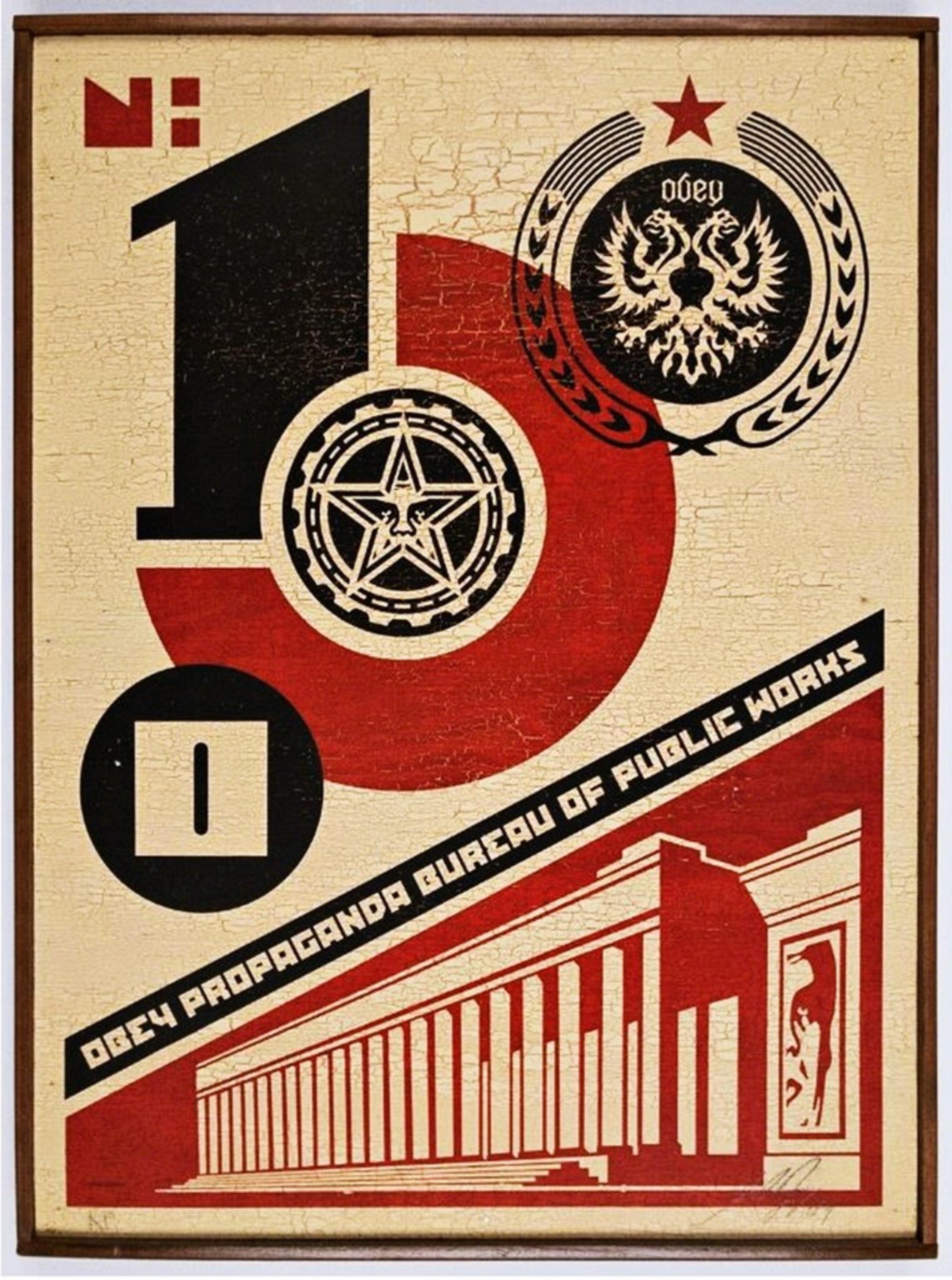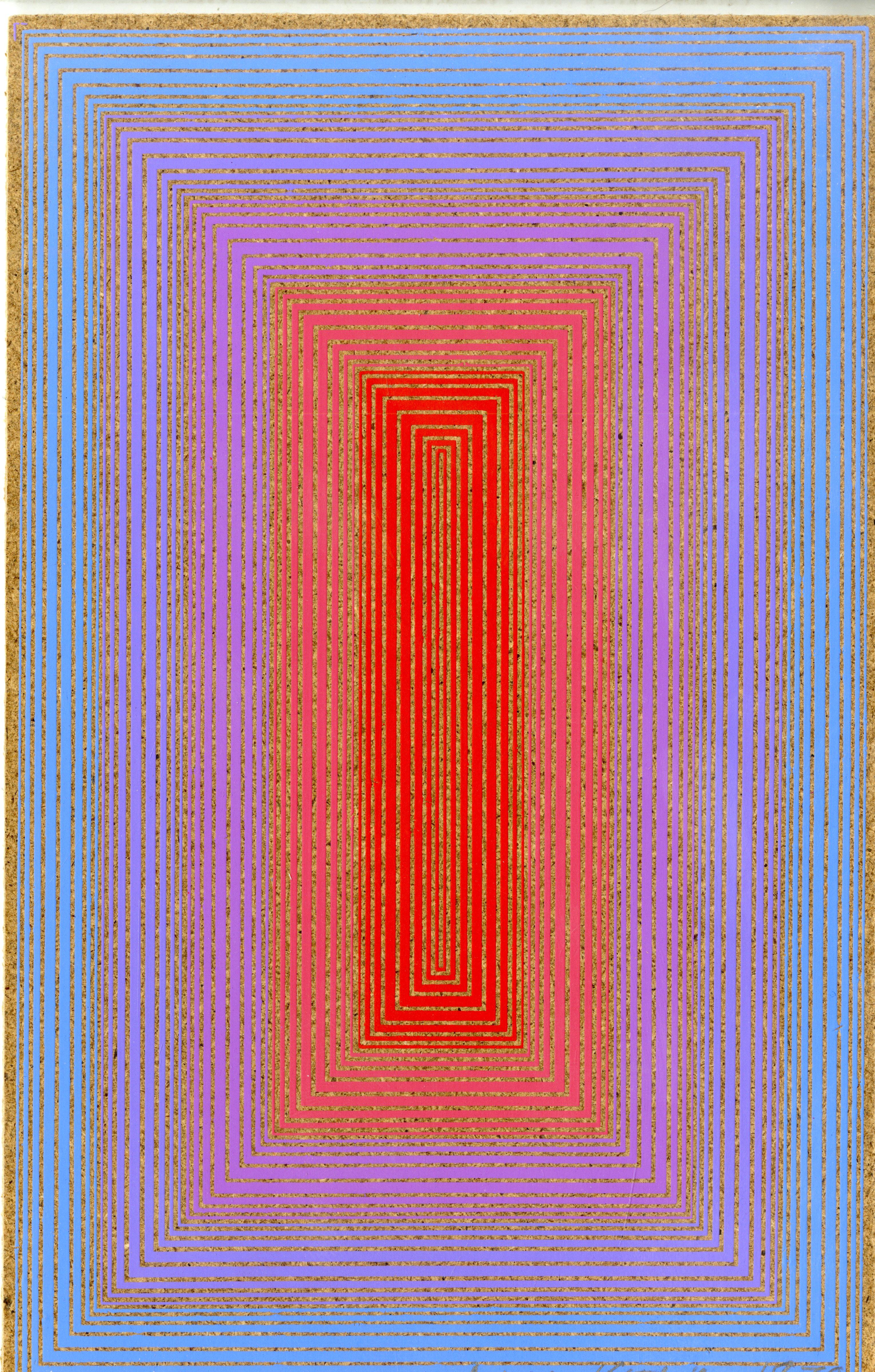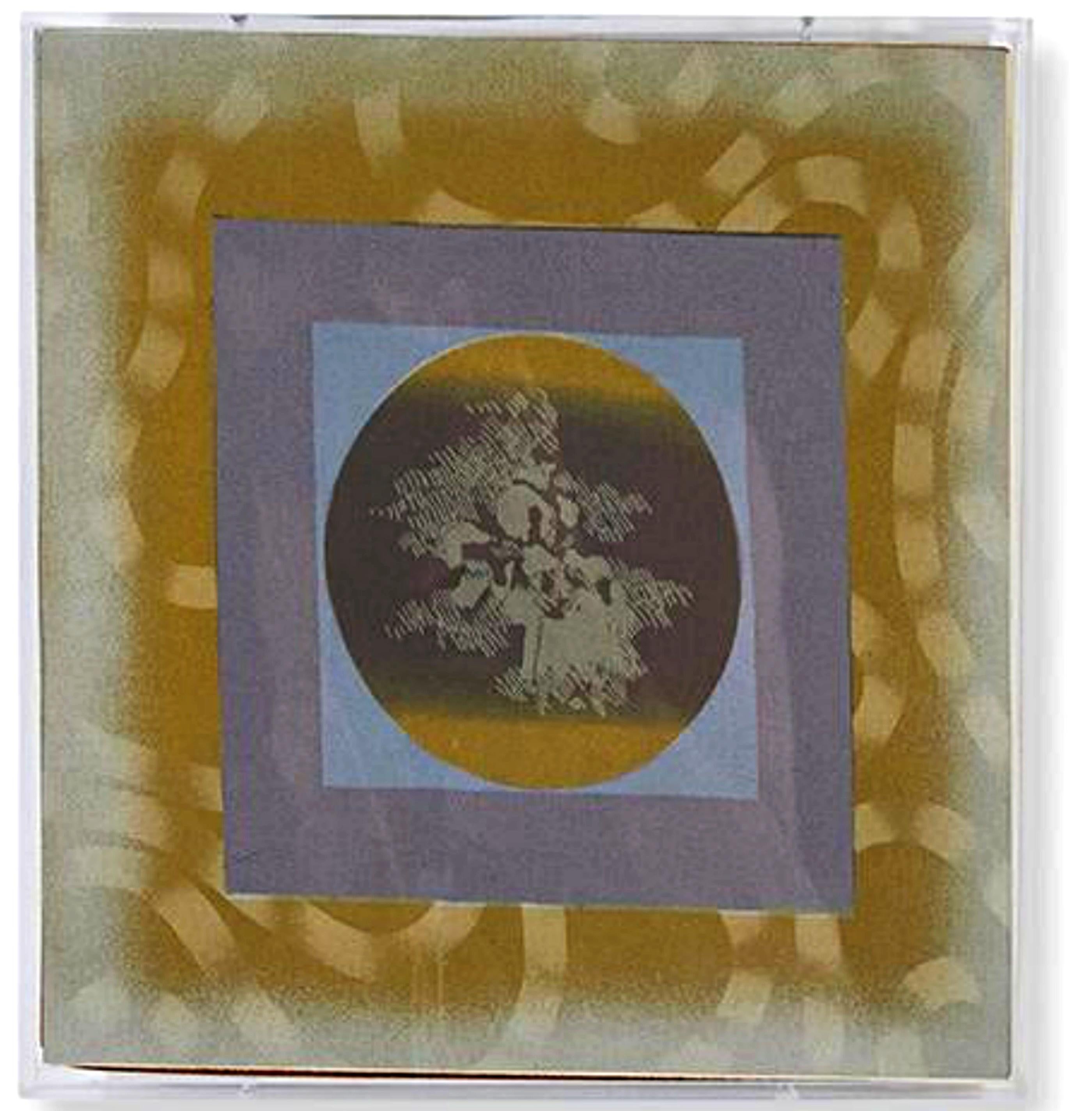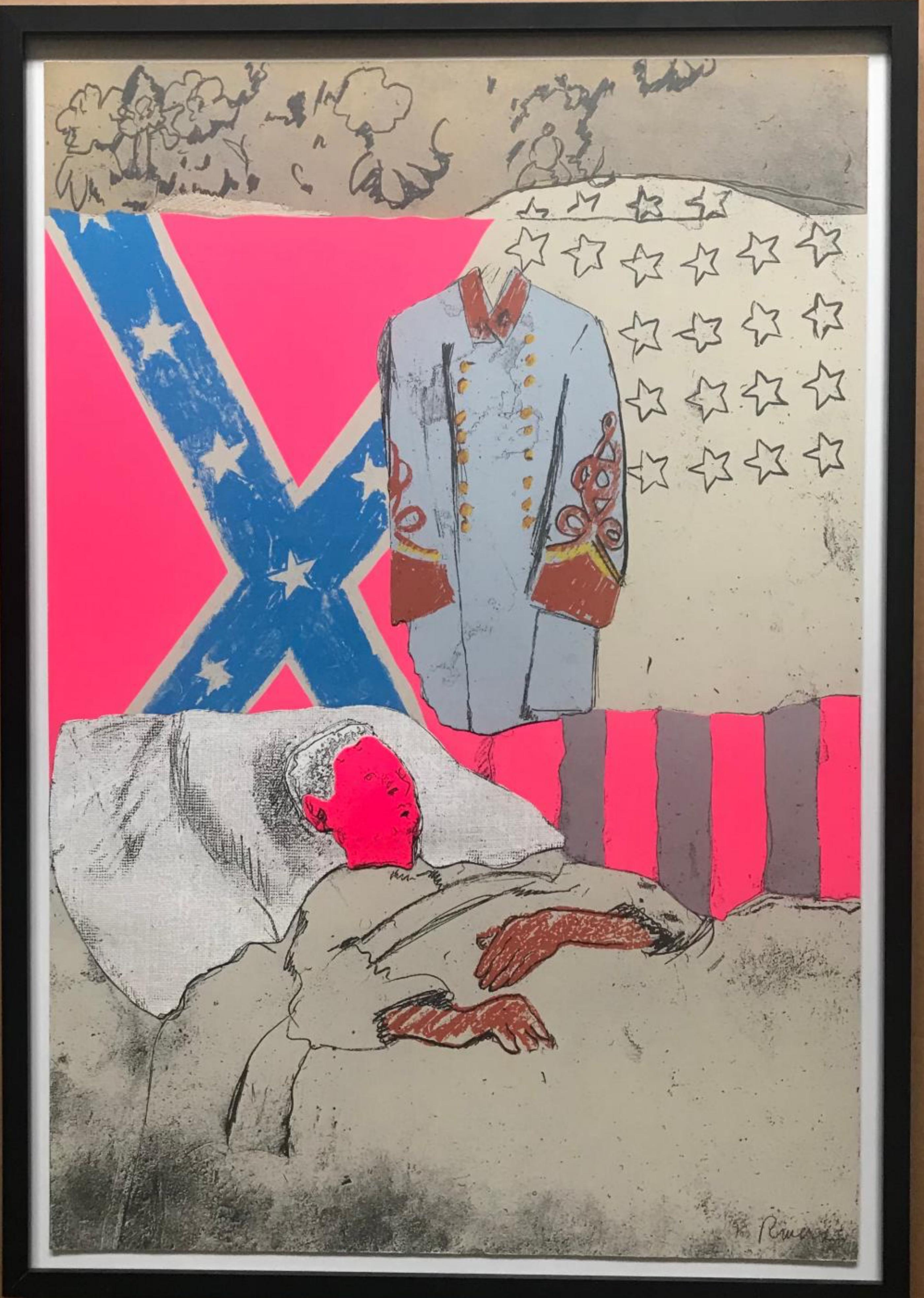Items Similar to The Appropriation piece: Andy Warhol, Frank Stella, Roy Lichtenstein Unique var.
Want more images or videos?
Request additional images or videos from the seller
1 of 8
Richard PettiboneThe Appropriation piece: Andy Warhol, Frank Stella, Roy Lichtenstein Unique var.1970
1970
About the Item
Richard Pettibone
The Appropriation Print Andy Warhol, Frank Stella, Roy Lichtenstein, 1970
Silkscreen in colors on masonite board (unique variant on sculpted board)
Hand-signed by artist, Signed and dated on the front (see close up image)
Bespoke frame Included
This is a rare example of Pettibone's iconic Appropriation Print, as it's silkscreened and sculpted on masonite board rather than paper, giving it a different background hue, and enabling it work to be framed so uniquely.
The Appropriation print is one of the most coveted prints Pettibone ever created ; the regular edition is on a full sheet with white background; the present example was silkscreened on board, allowing it to be framed in 3-D. While we do not know how many examples of this graphic work Pettibone created, so far the present work is the only one example we have ever seen on the public market since 1970. (Other editions of The Appropriation Print have been printed on vellum, wove paper and pink and yellow paper.)
This 1970 homage to Andy Warhol, Frank Stella and Roy Lichtenstein exemplifies the type of artistic appropriation he was engaging in early on during the height of the Pop Art movement - long before more contemporary artists like Deborah Kass, Louise Lawler, etc. followed suit.
This silkscreen was in its original 1970 vintage period frame; a bespoke custom hand cut black wood outer frame was subsequently created especially to house the work, giving it a distinctive sculptural aesthetic.
Measurements:
Framed 14.5 inches vertical by 18 inches horizontal by 2 inches
Work
13 inches vertical by 16.5 inches horizontal
Richard Pettibone biography:
Richard Pettibone (American, b.1938) is one of the pioneering artists to use appropriation techniques. Pettibone was born in Los Angeles, and first worked with shadow boxes and assemblages, illustrating his interest in craft, construction, and working in miniature scales. In 1964, he created the first of his appropriated pieces, two tiny painted “replicas” of the iconic Campbell’s soup cans by Andy Warhol (American, 1928–1987). By 1965, he had created several “replicas” of paintings by American artists, such as Warhol, Roy Lichtenstein (1923–1997), Ed Ruscha (b.1937), and others, among them some of the biggest names in Pop Art. Pettibone chose to recreate the work of leading avant-garde artists whose careers were often centered on themes of replication themselves, further lending irony to his work. Pettibone also created both miniature and life-sized sculptural works, including an exact copy of Bicycle Wheel by Marcel Duchamp (French, 1887–1968), and in the 1980s, an entire series of sculptures of varying sizes replicating the most famous works of Constantin Brancusi (Romanian, 1876–1957). In more recent years, Pettibone has created paintings based on the covers of poetry books by Ezra Pound, as well as sculptures drawn from the grid compositions of Piet Mondrian (Dutch, 1872–1944). Pettibone straddles the lines of appropriation, Pop, and Conceptual Art, and has received critical attention for decades for the important questions his work raises about authorship, craftsmanship, and the original in art. His work has been exhibited at the Institute for Contemporary Art in Philadelphia, the Museum of Modern Art in New York, the Museum of Contemporary Art in Miami, and the Laguna Art Museum in Laguna Beach, CA. Pettibone is currently based in New York.
"I wished I had stuck with the idea of just painting the same
painting like the soup can and never painting another painting.
When someone wanted one, you would just do another one.
Does anybody do that now?"
Andy Warhol, 1981
Since the mid-1960s, Richard Pettibone has been making
hand-painted, small-scale copies of works by other artists — a
practice due to which he is best known as a precursor of appropriation art — and for a decade now, he has been revisiting subjects from across his career. In his latest exhibitions at
Castelli Gallery, Pettibone has been showing more of the “same”
paintings that had already been part of his 2005–6 museum retrospective,1
and also including “new” subject matter drawn from
his usual roster of European modernists and American postwar
artists. Art critic Kim Levin laid out some phases of the intricate spectrum from copies to repetitions in her review of the
Warhol-de Chirico showdown, a joint exhibition at the heyday
of appropriation art in the mid-1980s when Warhol’s appropriations of de Chirico’s work effectively revaluated “the grand
old auto-appropriator”.
Upon having counted well over a dozen
Disquieting Muses by de Chirico, Levin speculated: “Maybe he
kept doing them because no one got the point. Maybe he needed the money. Maybe he meant it when he said his technique
had improved, and traditional skills were what mattered.”
On
the other side, Warhol, in her eyes, was the “latter-day exemplar
of museless creativity”.
To Pettibone, traditional skills certainly
still matter, as he practices his contemporary version of museless creativity. He paints the same painting again and again,
no matter whether anybody shows an interest in it or not. His
work, of course, takes place well outside the historical framework of what Levin aptly referred to as the “modern/postmodern wrestling match”,
but neither was this exactly his match
to begin with.
Pettibone is one of appropriation art’s trailblazers, but his diverse
selection of sources removes from his work the critique of the
modernist myth of originality most commonly associated with
appropriation art in a narrow sense, as we see, for example, in
Sherrie Levine’s practice of re-photographing the work of Walker
Evans and Edward Weston. In particular, during his photorealist
phase of the 1970s, Pettibone’s sources ranged widely across
several art-historical periods. His appropriations of the 1980s
and 1990s spanned from Picasso etchings and Brancusi sculptures to Shaker furniture and even included Ezra Pound’s poetry.
Pettibone has professed outright admiration for his source artists, whose work he shrinks and tweaks to comic effect but, nevertheless, always treats with reverence and care. His response
to these artists is primarily on an aesthetic level, owing much
to the fact that his process relies on photographs. By the same
token, the aesthetic that attracts him is a graphic one that lends
itself to reproduction. Painstakingly copying other artists’ work by hand has been a way of making
it his own, yet each source is acknowledged in
his titles and, occasionally, in captions on white
margins that he leaves around the image as an
indication that the actual source is a photographic image. The enjoyment he receives in copying
is part of the motivation behind doing it, as is
the pleasure he receives from actually being with
the finished painting — a considerable private
dimension of his work. His copies are “handmade
readymades” that he meticulously paints in great quantities in his studio upstate in New York; the commitment
to manual labor and the time spent at material production has
become an increasingly important dimension of his recent work.
Pettibone operates at some remove from the contemporary art
scene, not only by staying put geographically, but also by refusing to recoup the simulated lack of originality through the
creation of a public persona.
In so doing, Pettibone takes a real
risk. He places himself in opposition to conceptualism, and he is
apprehensive of an understanding of art as the mere illustration
of an idea. His reading of Marcel Duchamp’s works as beautiful
is revealing about Pettibone’s priorities in this respect.
When
Pettibone, for aesthetic pleasure, paints Duchamp’s Poster for
the Third French Chess Championship three times in slightly different sizes, he refuses the separation between the intellectual
and retinal dimensions, as well as any conceptual concern about
the redundancy of the material object.
-Courtesy of Castelli Gallery
- Creator:Richard Pettibone (1938, American)
- Creation Year:1970
- Dimensions:Height: 14.5 in (36.83 cm)Width: 18 in (45.72 cm)Depth: 2 in (5.08 cm)
- Medium:
- Movement & Style:
- Period:
- Condition:Very good vintage condition; the inner metal frame is vintage and the outer bespoke black wood frame is new; there is minor wear to the outer edges of the board.
- Gallery Location:New York, NY
- Reference Number:1stDibs: LU1745212649682
About the Seller
5.0
Platinum Seller
These expertly vetted sellers are 1stDibs' most experienced sellers and are rated highest by our customers.
Established in 2007
1stDibs seller since 2022
289 sales on 1stDibs
Typical response time: 1 hour
- ShippingRetrieving quote...Ships From: New York, NY
- Return PolicyA return for this item may be initiated within 1 day of delivery.
More From This SellerView All
- Bureau of Public Works (Mixed Media on Wood) Twice Signed Artists Proof Ed of 2By Shepard FaireyLocated in New York, NYSHEPARD FAIREY Bureau of Public Works (on Wood), 2004 Mixed media silkscreen on wood panel. Hand signed and annotated on both the recto and verso. In original handmade artist's frame...Category
Early 2000s Pop Art Mixed Media
MaterialsWood, Mixed Media, Screen, Pencil
- Aufbruch Aus Moskau MockBa: Suite of 20 signed prints top Russian artists 64/100Located in New York, NYVARIOUS ARTISTS AUFBRUCH AUS MOSKAU MOCKBA - PORTFOLIO OF TWENTY (20) ORIGINAL LIMITED EDITION SIGNED GRAPHICS, 1990 20 Limited edition, hand signed and numbered Screenprints, unfram...Category
1990s Pop Art Abstract Prints
MaterialsMixed Media, Screen, Linen, Pencil
- ROBOT Triptych (Set of Three (3) Skateboards)By Jean-Michel BasquiatLocated in New York, NYJean-Michel Basquiat ROBOT Triptych (Set of Three (3) Skateboards), 2017 Set of 3 Silkscreens on 7-Ply Canadian Maplewood Skate Decks (Set of 3) Estate of Jean-Michel Basquiat copyri...Category
2010s Pop Art Abstract Prints
MaterialsWood, Maple, Mixed Media, Screen
- With all My Flowering Heart Skateboard Triptych, 3 Limited Edition Skate DecksBy Yayoi KusamaLocated in New York, NYYayoi Kusama With All My Flowering Heart (Triptych), 2014 Set of Three (3) Separate Limited Edition numbered skate decks on 7-ply Canadian maple wood 31 × 8 × 2/5 inches (each) Hand ...Category
2010s Pop Art Mixed Media
MaterialsWood, Mixed Media, Permanent Marker, Screen
- Annual Edition, Lt. Ed. 1970s mixed media Op Art silkscreen on board hand signedBy Richard AnuszkiewiczLocated in New York, NYRichard Anuszkiewicz Annual Edition, 1970 Silkscreen on Masonite Signed and dated in graphite pencil lower right recto. Edition of 100 8 × 5 1/10 × 1/5 inches Unframed Signed and dat...Category
1970s Abstract Geometric Abstract Prints
MaterialsMasonite, Screen, Graphite
- New York City Center mid 1960s geometric design Deluxe hand signed and numberedBy Robert IndianaLocated in New York, NYRobert Indiana New York City Center of Music and Drama (Hand signed limited edition), 1968 Color Silkscreen 35 × 25 inches Edition 23/144 Hand signed and dated lower right recto; num...Category
1960s Pop Art Abstract Prints
MaterialsScreen, Pencil
You May Also Like
- BagsLocated in Santa Monica, CASilkscreen/Collage on Retail BagsCategory
21st Century and Contemporary Pop Art Mixed Media
MaterialsScreen
- ST1b99-Contemporary, Abstract prints, stil-life, figurative, nude, landscapeBy Francisco NicolásLocated in London, LondonFlowers 09, 2019 Edition of 25 Digital pigment print Ultrachrome ink on Fabriano Rosaspina paper. Hand signed by the artist, and certificate of authenticity, (Unframed) His work h...Category
2010s Pop Art Abstract Prints
MaterialsPaper, Mixed Media, C Print, Inkjet, Giclée, Pigment, Archival Pigment
- Hematriptan mRNA (Black), Agent X, Futuristic Artwork, Limited EditionBy Agent XLocated in Deddington, GBHematriptan mRNA(Black) by Agent X [2021] limited edition Mixed Media Edition of 70 Image size: H:85 cm x W:96 cm Complete Size of Unframed Work: H:85 cm x W:96 cm x D:1cm Sold Unfr...Category
21st Century and Contemporary Pop Art Mixed Media
MaterialsMixed Media
- ST1b99-Contemporary, Abstract prints, stil-life, figurative, nude, landscapeBy Francisco NicolásLocated in London, LondonFlowers 09, 2019 Edition of 25 Digital pigment print Ultrachrome ink on Fabriano Rosaspina paper. Hand signed by the artist, and certificate of authenticity, (Unframed) His work h...Category
2010s Pop Art Abstract Prints
MaterialsPaper, Mixed Media, C Print, Inkjet, Giclée, Pigment, Archival Pigment
- ST107B-Contemporary, Abstract prints, stil-life, figurative, nude, landscapeBy Francisco NicolásLocated in London, LondonEdition of 25 Digital pigment print Ultrachrome ink on Fabriano Rosaspina paper. Hand signed by the artist, and certificate of authenticity, (Unframed) His work has been shown in...Category
2010s Pop Art Abstract Prints
MaterialsArchival Pigment, Paper, Mixed Media, C Print, Color, Digital Pigment
- HEART II Signed Hand Colored Lithograph, Love Symbol, Red, Yellow, TurquoiseBy Peter MaxLocated in Union City, NJHEART II - is a unique, hand colored lithograph by the pop culture icon - Peter Max. The image Heart II was printed in 1981 as a limited edition lithograph of 165, using traditional...Category
1980s Pop Art Mixed Media
MaterialsMixed Media, Lithograph
Recently Viewed
View AllMore Ways To Browse
Homage Lichtenstein
Homage To Lichtenstein
Yellow Warhol
Hand Signed Roy Lichtenstein
Frank Stella Original
Louise Lawler
Louis Vuitton Guys
Rosy De Palma
Calvin Burnett
Louis Vuitton Drip Painting
Rick Owens 1990
Craig Tracy
Dtr Modern Galleries Hirst
Gabriel De La Mora
Hwa Painter
Louis Vuitton Guy
Riding In Cars With Boys
Chanel Cohn





